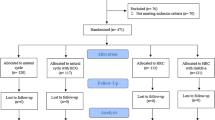Abstract
Purpose
A thin endometrium is one of the most difficult problems encountered in assisted reproduction every day practice. Whether a daily dose of 150 IU HCG for 7 days concomitant with estrogen administration in estrogen replacement cycles can increase the endometrial thickness and improve pregnancy outcome, was the objective of the current study.
Methods
Seventeen infertile patients with successive implantation failures and resisting thin endometrium, being recipients of fresh donor or frozen embryos were recruited. This was a prospective cohort, proof of concept study, NCT01768247. On day-8 or 9 of the estrogen administration, and continuing 8 mg estrogen per day, subcutaneous injections of 150 IU HCG were initiated daily for 7 days. After a week on HCG priming, (day-14 or 15) endometrial thickness was controlled with ultrasound, and progesterone was initiated.
Results
Mean endometrial thickness was increased from 5.2 mm to 6 mm (p = 0.008). 35.3 % of the patients had more than 20 % improvement of their endometrial thickness after HCG priming. 17 % achieved an endometrial thickness more than 7 mm, and 29.4 % did not improve their thickness at all. Interestingly, from the later two became pregnant. Overall, 41 % of them (7/17) finally delivered.
Conclusions
One hundred fifty IU HCG endometrial priming for 7 days in the proliferative phase of estrogen substituted cycles for frozen embryos is highly promising, as not only the thickness of the endometrium improves but also eventually the receptivity appears normalized.
Similar content being viewed by others
References
Andersen AN, Devroey P, Arce JC. Clinical outcome following stimulation with highly purified hMG or recombinant FSH in patients undergoing IVF: a randomized assessor-blind controlled trial. Hum Reprod. 2006;21:3217–27.
Bourdiec A, Shao R, Rao CV, Akoum A. human chorionic gonadotropin triggers angiogenesis via the modulation of endometrial stromal cell responsiveness to interleukin 1: a new possible mechanism underlying embryo implantation. Biol Reprod. 2012;87:66.
Bourgain C, Devroey P. Histologic and functional aspects of the endometrium in the implantatory phase. Gynecol Obstet Invest. 2007;64:131–3.
Check JH, Graziano V, Lee G, Nazari A, Choe JK, Dietterich C. Neither sildenafil nor vaginal estradiol improves endometrial thickness in women with thin endometria after taking oral estradiol in graduating dosages. Clin Exp Obstet Gynecol. 2004;31:99–102.
Chen MJ, Yang JH, Peng FH, Chen SU, Ho HN, Yang YS. Extended estrogen administration for women with thin endometrium in frozen-thawed in-vitro fertilization programs. J Assist Reprod Genet. 2006;23:337–4.
Cicek N, Eryilmaz OG, Sarikaya E, Gulerman C, Genc Y. Vitamin E effect on controlled ovarian stimulation of unexplained infertile women. J Assist Reprod Genet. 2012;29:325–8.
Detti L, Yelian FD, Kruger ML, Diamond MP, Puscheck EE. Endometrial thickness dynamics and morphologic characteristics during pituitary downregulation with antagonists in assisted reproductive technology cycles. J Ultrasound Med. 2008;27:1591–6.
Dix E, Check JH. Successful pregnancies following embryo transfer despite very thin late proliferative endometrium. Clin Exp Obstet Gynecol. 2010;37:15–6.
Elizur SE, Son WY, Yap R, Gidoni Y, Levin D, Demirtas E, et al. Comparison of low-dose human menopausal gonadotropin and micronized 17beta-estradiol supplementation in in-vitro maturation cycles with thin endometrial lining. Fertil Steril. 2009;92:907–12.
Fatemi HM, Popovic-Todorovic B, Papanikolaou E, Donoso P, Devroey P. An update of luteal phase support in stimulated IVF cycles. Hum Reprod Update. 2007;13:581–90.
Gleicher N, Vidali A, Barad DH. Successful treatment of unresponsive thin endometrium. Fertil Steril. 2011;95:2123.
Licht P, Russu V, Lehmeyer S, Wildt L. Molecular aspects of direct LH/hCG effects on human endometrium–lessons from intrauterine microdialysis in the human female in vivo. Reprod Biol. 2001;1:10–9.
Licht P, von Wolff M, Berkholz A, Wildt L. Evidence for cycle-dependent expression of full-length human chorionic gonadotropin/luteinizing hormone receptor mRNA in human endometrium and decidua. Fertil Steril. 2003;79 Suppl 1:718–23.
Prapas N, Tavaniotou A, Panagiotidis Y, Prapa S, Kasapi E, Goudakou M, et al. Low-dose human chorionic gonadotropin during the proliferative phase may adversely affect endometrial receptivity in oocyte recipients. Gynecol Endocrinol. 2009;25:53–9.
Reshef E, Lei ZM, Rao CV, Pridham DD, Chegini N, Luborsky JL. The presence of gonadotropin receptors in nonpregnant human uterus, human placenta, fetal membranes, and decidua. J Clin Endocrinol Metab. 1990;70:421–30.
Saha TK, Amer SA, Biss J, Thakare H, Williams S, Farrell CT, et al. The validity of transvaginal ultrasound measurement of endometrial thickness: a comparison of ultrasound measurement with direct anatomical measurement. BJOG. 2004;111:1419–24.
Senturk LM, Erel CT. Thin endometrium in assisted reproductive technology. Curr Opin Obstet Gynecol. 2008;20:221–8.
Sher G, Herbert C, Maassarani G, Jacobs MH. Assessment of the late proliferative phase endometrium by ultrasonography in patients undergoing in-vitro fertilization and embryo transfer (IVF/ET). Hum Reprod. 1991;6:232–7.
Shufaro Y, Simon A, Fatum M. Thin unresponsive endometrium—a possible complication of surgical curettage compromising ART outcome. J Assist Reprod Genet. 2008;25:421–5.
Zenke U, Chetkowski RJ. Transfer and uterine factors are the major recipient-related determinants of success with donor eggs. Fertil Steril. 2004;82:850.
Zhu W, Chen M, Liu J, Fu Z, Li X, Qin C, et al. Receptivity assessment of an ultrasonographic homogeneous endometrium in the late follicular phase of infertile women with natural cycles. Am J Obstet Gynecol. 2012;207:511–7.
Author information
Authors and Affiliations
Corresponding author
Additional information
Capsule HCG endometrial priming in the proliferative phase of estrogen substituted cycles for frozen embryos improve both thickness and reproductive outcome.
Rights and permissions
About this article
Cite this article
Papanikolaou, E.G., Kyrou, D., Zervakakou, G. et al. “Follicular HCG endometrium priming for IVF patients experiencing resisting thin endometrium. A proof of concept study”. J Assist Reprod Genet 30, 1341–1345 (2013). https://doi.org/10.1007/s10815-013-0076-0
Received:
Accepted:
Published:
Issue Date:
DOI: https://doi.org/10.1007/s10815-013-0076-0




